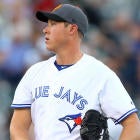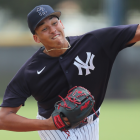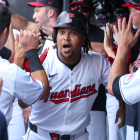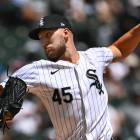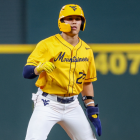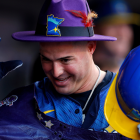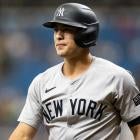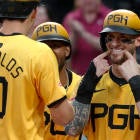With the regular season concluding, we've decided to take a look at each team's future -- not by using a crystal ball or other psychic abilities, but by evaluating their farm systems. Below you'll find our ranking of the top five prospects in the organization -- sorted by perceived future potential -- as well as five other players who fit various categories. Those categories are:
2020 contributor: A player who is likely to play a role for the big-league team next season.
Analyst's pick: A player who is a strong statistical performer and/or whose underlying measures are better than the scouting reports suggest.
Riser: A player on the way up.
Faller: A player on the way down.
One to watch: An interesting player to keep in mind (for whatever reason).
These rankings were compiled after talking with various industry sources about the systems (and players) in question. It should be acknowledged that this process is more art than science, and that there are limits to ordinal rankings. Still, it's an intuitive system, and our hope is that the write-ups will answer any questions by providing additional context and analysis of each player -- such as their pluses and minuses; the risk factors involved; and their estimated arrival date.
One last word on eligibility: we're following MLB's rookie guidelines by disqualifying any player with more than 130 big-league at-bats or 50 innings pitched.
Few teams have graduated more talent in the past year than the Toronto Blue Jays -- gone from these kinds of lists are Vladimir Guerrero Jr., Bo Bichette and Cavan Biggio. Still, the Jays have a few intriguing prospects and some youngsters who you should keep in mind over the coming years.
1. Nate Pearson, RHP
Few pitchers, let alone prospects, have as much arm strength as Nate Pearson, who hit 103 mph during last year's Arizona Fall League All-Star Game.
Nate Pearson -- 103 miles. per. hour. 😳😳 pic.twitter.com/o6pcZArYrz
— Sporting News Canada (@sportingnewsca) November 4, 2018
Pearson was in the Fall League because he had missed most of the regular season due to a fractured forearm. He rebounded just fine in 2019, tossing 101 ⅔ innings across three levels. His final three starts occurred in Triple-A, where he struck out 15 batters in 18 frames. It's fair to think, then, that Pearson will make his big-league debut in 2020 -- potentially early on, too.
Pearson obviously possesses a power arsenal, complete with a high-grade fastball and an above-average slider that he can deliver harder than some pitchers' heaters. The rest of his arsenal is closer to average, but the bigger concern here has to do with his workload. Even including his collegiate days, he's yet to throw as many as 105 innings in a season.
Pearson becoming a front-of-the-rotation monster is within the realm of possibilities. But tempering expectations, at least in the short term, could prove to be a prudent decision.
2. Jordan Groshans, SS
The No. 12 pick in the 2018 draft, Jordan Groshans was limited to 23 games in 2019 due to a foot injury. He made the most of it when he played by batting .337/.427/.482 in A-ball.
Though Groshans played shortstop exclusively this season, he's likely to end up at third base. The more important aspect of his game is his bat. Groshans marries a mature approach with good power potential, giving him the chance to be an above-average contributor with the stick. His swing does feature a hitch and he did strike out more than 21 percent of time this year, so it'll be worth keeping an eye on the adjustments he makes (or doesn't make) as he faces more advanced pitching in the coming years.
Provided Groshans makes a full recovery, he'll enter next season as the Jays' best hitting prospect -- and the person who might force Vladimir Guerrero Jr. to another position.
3. Alek Manoah, RHP
Alek Manoah tied Chris Enochs as the highest player ever drafted from West Virginia University when the Blue Jays picked him 11th back in June. Manoah just hopes he can do something Enochs didn't -- reach the majors. It's likely, but it's not yet apparent in what role.
Manoah has some innate qualities that would seem to bode well for his long-term starting prospects. He's a big-bodied right-hander, listed at 6-foot-6 and 260 pounds, who would seem perfect for gobbling up innings. He also has a pair of above-average offerings in his fastball and slider, and seemingly made progress as it pertains to his strike-throwing ability. He walked fewer than three batters per nine in more than 125 collegiate and professional innings -- this after having issued at least 4.7 walks per nine in his first two seasons with the Mountaineers.
Still, some teams were known to be skeptical about Manoah during the draft process because of his limited history of throwing strikes. Should his command falter heading forward, he could wind up in the bullpen -- albeit, potentially, as a high-leverage arm.
4. Simeon Woods-Richardson, RHP
Part of the Marcus Stroman bounty alongside Anthony Kay, Simeon Woods-Richardson offers more upside than Kay and is the key to the trade from Toronto's point of view.
The Blue Jays sent Woods-Richardson to High-A after the deal, and he proved up to the challenge by striking out 29 batters in 28 innings and posting a 2.54 ERA. Most of the ingredients for a mid-rotation starter are here. Woods-Richardson has a sturdy frame and is more than athletic enough to repeat his delivery. He has a lively arm that produces a quality fastball and a breaking ball that should serve as his main out pitch heading forward.
As is the case with most teenagers -- and remember, Woods-Richardson won't turn 20 until after next season -- he needs to keep refining his changeup and his command. Should he fail to do so, for whatever reason, then he could end up a quality late-inning reliever.
5. Eric Pardinho, RHP
You might recall Eric Pardinho from the 2016 World Baseball Classic. If not, he pitched for Brazil in that tournament as a 15-year-old. He's 18 now, having since signed with the Blue Jays for $1.4 million in 2017, but continues to pitch beyond his years.
Pardinho's polish is his best attribute and he receives high marks for his aptitude on the mound. He also throws four offerings that check in around average or slightly better. Like Julio Urias before him, Pardinho is on the smaller side for a starter (listed at 5-foot-10 and 155 pounds) and will likely see his workload managed over the coming years. To wit, he dealt with a sore elbow during spring and was later shut down early for rest purposes after tallying just 37 innings.
Another downside with Pardinho is his perceived lack of upside. While he's known to be a proponent of Trackman data, it's to be determined if he can use that information to improve one of his breaking balls, or otherwise develop a true out pitch. Without further improvement, he's likely to top out as a mid-rotation arm -- and that's if his body permits him to remain a starter.
2020 contributor: Anthony Kay, LHP
The aforementioned Anthony Kay, the other part of the return on Stroman, has already appeared in the majors despite making just 49 minor-league starts to date. He's a three-pitch lefty -- fastball, changeup, curveball -- who may not have a plus offering at his disposal. Historically a flyball pitcher, it's least worth wondering if Kay will miss enough bats and barrels to become more than a back-end starter in the majors. The Blue Jays owe it to themselves to find out, so expect Kay to receive ample opportunity in 2020 and beyond.
Analyst's pick: Curtis Taylor, RHP
The Blue Jays acquired Curtis Taylor as part of the Eric Sogard trade -- that despite him having not pitched since May due to arm woes. Taylor is a well-constructed right-hander with a reliever's arm action and a quality fastball-slider pairing. If he's healthy, he should make his big-league debut in 2020, and should blossom into a useful middle reliever.
Riser: Miguel Hiraldo, 2B
Miguel Hiraldo won't turn 20 until next September, but he's already shown an advanced bat. Hiraldo hit .299/.346/.485 with seven homers and 11 steals in the Appalachian League. Numbers don't mean a heck of a whole lot at that level or his age. Fortunately, he looks the part, too -- even if he does step in the bucket often. The question with Hiraldo is where he'll wind up defensively. He's a natural shortstop yet second base seems like the expected destination. Provided he continues to do his thing in the batter's box, he'll be moving up lists in short order.
Faller: Kevin Smith, INF
Entering the season, Kevin Smith already appeared buried on the organizational depth chart behind Bichette, Biggio and Lourdes Gurriel Jr. Smith is in no better position now, having suffered through a poor season that saw him strike out roughly a third of the time in Double-A. All the telltale signs of the modern swing change -- more flyballs, more pulling -- are there except for the most important part: improved results. Smith will need to keep tinkering this winter to find a solution -- if he does, this season might be overlooked as a silent bob on his way to turning into a Sean Rodriguez-like spare infielder.
One to watch: Orelvis Martinez, SS
Note that we're putting Orelvis Martinez here instead of in the "Riser" category because he received a $3.5 million signing bonus back in July 2018 -- in other words, his ascent is to be expected. Martinez won't turn 18 until November, but he hit .275/.352/.549 in 40 games in rookie ball, which makes for a fine first line on his Baseball-Reference page. The Blue Jays are cross-training him at both left-side infield positions, and there's a fair chance he's a third baseman in the long run. The good news is that Martinez has legitimate offensive upside. Check back in a year or two -- when you do, he could be near the top of the page.









